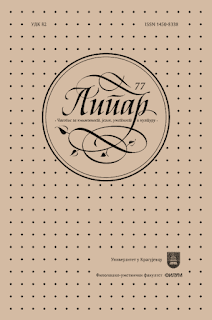СЛИКА МЕДИТЕРАНА У СРПСКОЈ КЊИЖЕВНОСТИ: "ВЕНЕЦИЈА" ВЛАДИМИРА ПИШТАЛА
THE PICTURE OF THE MEDITERRANEAN IN SERBIAN LITERATURE: "VENICE" OF VLADIMIR PIŠTALO
Author(s): Milica G. PerićSubject(s): Language and Literature Studies, Studies of Literature, Serbian Literature, Theory of Literature
Published by: Универзитет у Крагујевцу
Keywords: the Mediterranean;Venice;Vladimir Pištalo,;carnival;commedia dell’arte;metaphor
Summary/Abstract: Consideration of carnival and commedia dell’arte, as key achievements of the Mediterranean, its metonymic representation on the example of Venice, and seeing this phenomenon as the source of all metamorphoses, form the basis of research based on five analytical-methodological frameworks of E. Šeleva for the study of the Mediterranean literature. At the beginning of the novel, it is explained when and how the narrator became infected with Venice. The central part shows his contact with this city and their internal dialogue, while the final part shows how much power this great city has. In Vladimir Pištalo’s novel, Venice is a symbol of light and curse, change. It is also his muse, all that Venus is to Casanova. The transformation of the narrator’s personality conditioned by the contact with Venice and the Mediterranean is visible on several levels: a) transformation as a change of individuals and society on the night of the carnival, b) transformation as a consequence of the hero-narrator’s growing up, c) transformation presented in the experience of Venice and the Mediterranean in the relation Tripko – narrator. It is concluded that Pištalo’s poetically masterfully shaped novel is a metaphor of an inexhaustible thirst for beauty, conceived at the moment of meeting it, as well as a story about constant self-examination and eternal return.
Journal: Липар - часопис за књижевност, језик, уметност и културу
- Issue Year: XXIII/2022
- Issue No: 77
- Page Range: 203-211
- Page Count: 9
- Language: Serbian

